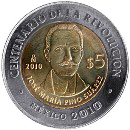Coins issued on 2008
A revolutionary from Sonora whose military talents made him the most important military asset of Constitutionalism. He stood out in his battles against federal forces as well as against the Conventionalists, when he defeated Francisco Villa's Northern Division at the Bajío region. His radicalism set him against the moderate positions of Carranza and led him to proclaim the Plan of Agua Prieta against the wishes of the First Constitutionalist Chief (that is, Carranza). He was president of Mexico from 1920 to 1924, when he promoted agricultural policies, formed worker organizations, obtained international recognition for the new regime, and initiated the application of the Constitution's anticlerical laws. In 1928, he attempted to occupy Mexico's presidency for another term, but was assassinated by a religious fanatic. The construction of contemporary Mexico and of the regime that emerged from the Mexican Revolution began with Obregón.
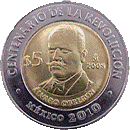
Lawyer and member of the Youth Athenaeum, who in 1910 joined Madero's movement and later that of Villa. At the victory of the Revolution, he became rector of the National University. From 1921 to 1924, he acted as Head of the Ministry of Public Education, doing an extraordinary job promoting education for the masses, establishing many libraries, putting the literary classics in reach of the general public, and supporting the Mexican visual arts (in particular, the art of muralists). Summing up, he gave the Mexican Revolution an artistic expression and its own culture.
Despite his well-recognized work, throughout the years, Vasconcelos distanced himself from national politics. Nonetheless, and although in an ephemeral way, he went back into politics when he launched his presidential candidacy in 1929. His written work, of a historical, philosophical, and sociological nature, has enjoyed widespread acceptance up to our own time.
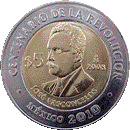
When Madero's revolt broke out, Francisco Villa joined the revolutionary contingent thanks to the intervention of Abraham González. In a short while, Villa stood out for his military talents and his knowledge of the terrain, obtained during his years as a cattle thief. He raised the most important military force of the Revolution: the Northern Division, which took Zacatecas, among other feats, a city that was a hub for the federal army, and with that victory, defeated the army of Victoriano Huerta. The sense of social justice in Villa's cause, evident during his governorship of Chihuahua, ended up putting him against Constitutionalism.
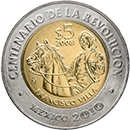
Union member, military man, politician, and revolutionary from Veracruz. He was one of the first to graduate from the Antón Lizardo Naval Academy. He directed, in 1914, the action of the cadets of this school against the North American invasion. He joined the Constitutionalist Army and attained the rank of General. He was a congressional representative for his native state to the Constitutional Congress of Querétaro. In Congress, he joined the radical group and greatly influenced the edition of Article 123, as well as others that gave profound social meaning to the Constitution. A well-known figure in both Veracruz and national politics, he occupied several government positions when the Revolution was over until he retired to private life. Heriberto Jara was a distinguished man who dedicated his life to attaining revolutionary ideals.
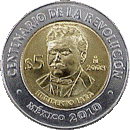
Politician, journalist, and dramatist. He began his public life as a journalist at El Demócrata, an opposition daily. In 1900, he founded the newspaper Regeneración , which published critiques of the Porfiriato regime that landed him in jail. Once free, in 1902, he contributed to El Hijo del Ahuizote, which got him arrested again and exiled to San Antonio, Texas, where he began publishing Regeneración again. Persecuted for this cause, he moved to Saint Louis, Missouri, where he continued editing his newspaper. There, in 1906, he formed the Mexican Liberal Party, which profoundly influenced the first vestiges of opposition against the Porfiriato regime. In January 1911, he promoted the uprising of Baja California, taking Mexicali and Tijuana. Madero attempted in vain to incorporate him in his movement, but Flores Magón, head of the Californian rebels, did not believe in what was considered to be a “bourgeois revolution.” Analytical and critical, Flores Magón called attention to the actions he considered unjust on the part of Madero and later, on the part of Victoriano Huerta. His ideals of social justice and freedom for the poor were given form mainly in two theatrical works he wrote—the revolutionary dramas Tierra y Libertad and Verdugos y Víctimas, both trenchantly critical of society. He is considered one of the most influential ideologists of the Mexican Revolution.
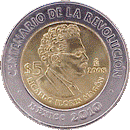
Revolutionary from Michoacán who dedicated himself to journalism since 1906 and founded several opposition dailies to the government. In 1910 he joined the Revolutionary Junta of San Antonio, Texas, which organized the first steps of the Revolution under Madero. In 1911, he participated along with Pascual Orozco in taking Ciudad Juárez. When Madero died, he joined the Constitutionalist movement. He took part in the first agrarian partitioning, which took place in 1913, led by Lucio Blanco. He was one of the signers of the Guadalupe Plan promoted against the usurper Victoriano Huerta.
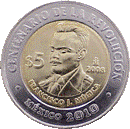
Coins issued on 2009
Teacher and journalist from San Luis Potosí whose work was set down in El Monitor Republicano and La Patria and, more than anywhere else, in the daily he founded in 1861, El diario del hogar, which expressed his anti-Porfirian ideas. Through his newspaper, he definitely aided Madero's movement, for which he was persecuted and jailed. He died in 1911 from illnesses contracted during his imprisonment. The life and work of Mata represent critical journalism and the full exercise of the liberties of free speech and a free press.
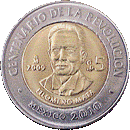
Worked enthusiastically alongside her brothers Aquiles and Máximo in the anti-reelection movement and on Madero's campaigns. In October 1910 she moved to San Antonio, Texas, to gather funds for the Maderista revolution. When her house in Puebla was attacked by federal and state forces, she courageously appeared on the balcony, rifle in hand, to harangue the people, an act in which she was wounded. When the resistance within her house was exhausted, she was arrested and sent to the Merced prison. When Huerta's coup was overthrown, she became a nurse. Her intense work in the anti-reelection campaign gives her an important place in the history of the Mexican Revolution. Along with her brothers she is considered to be an initiator of the Mexican Revolution. In Luz y Proceso, she declared that the Republic would be saved not by men used to governing it despotically, but “by men who have not soiled their consciences by committing crimes against the law.”
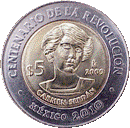
Lawyer born in Jilotepec, Estado de México, who also worked as a journalist and was well known for his ethnographic work, but mostly for his study Los Grandes Problemas Nacionales (Main Domestic Problems), published in 1909. This study was the most important of those on social problems written during the Porfiriato and one of the most influential books in the field of revolutionary ideas. In the study, the author supports more solidly than any other up to that time the contribution of mestizos and the importance of mestizaje in Mexico, but above all, he analyzes in detail the country's agrarian problem. Molina's analyses of the Mexican countryside led him to support land repartition. Thus, when the victorious Maderista movement ignored the agrarian issue, he proposed the Plan of Texcoco in 1911 and rebelled against the regime. He was imprisoned for two years, but he never stopped expressing his ideas in El diario del hogar.
His agrarian ideas were famously influential in different laws on the matter, such as the law of January 6, 1915 and in the Mexican Constitution's Article 27 on land ownership.
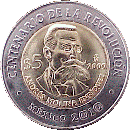
Supporter of the Maderista movement and, starting in 1913, member of the Constitutionalist movement. He held many positions and headed many commissions for Venustiano Carranza. Among them, he was Carranza's confidential agent in the United States, he was finance minister, he developed the first Constitutionalist agrarian reform project, and he held the position of president of the Mexican Commission for U.S. Citizens' Claims. When Carranza was assassinated, he distanced himself from politics, although he continued his intense historical, literary, and economic writing. He was without a doubt one of the most important intellectuals of the Mexican Revolution and Constitutionalism.
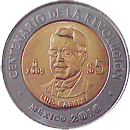
A follower of Ricardo Flores Magón, who from the beginning of the Revolution joined Madero's movement and, in 1913, the Constitucionalist movement. In November 1914, the Supreme Revolutionary Convention of Aguascalientes designated him as provisional president, a post he held until January 1915. Although he tried to incorporate in his government representatives from different revolutionary factions, in the end he isolated himself and was set against them.
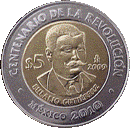
Teacher from Morelos who, when the Revolution broke out, joined the Zapatista forces in Cuautla. He is considered to be the writer who penned the Plan of Ayala, the key agrarian program of the Mexican Revolution. He took part in the Revolutionary Convention and in 1917 was shot by firing squad by Zapatista troops.
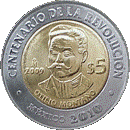
Doctor and politician from Chiapas. Educated in an environment of liberal ideas, he founded the regional newspaper El Vate, in which he published articles critical of President Porfirio Díaz and of the governor of Chiapas, Rafael Pimentel. He was elected president of the municipality of Comitán in 1911 and the following year, substitute senator for the same place. When the senator for whom he was substituting died, he occupied the seat (in 1913).
When Madero was assassinated, Belisario Domínguez fought actively against Victoriano Huerta. In Congress, he tried to give a famous speech against Huerta's regime. Unable to read it in the congressional session, he printed it and distributed it widely.
In October 1913, federal troops under Huerta's command arrested and assassinated him in Coyoacán. Public outrage was so fierce that Congress was dissolved and many popular representatives were jailed. However, the death of Belisario Domínguez contributed to the fall of Huerta's spurious regime and symbolized the defense of legality and republicanism against the regime established through a coup d'état.
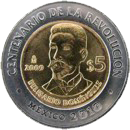
Coins issued on 2010
In the wake of the democratic opening announced by Porfirio Díaz in 1908, Francisco I. Madero published “Presidential Succession” in 1910 and later presented his own candidacy as president of the Republic for the Anti-reelection Party, which fought an extensive national political campaign garnering wide popular support. Just after General Porfirio Díaz was declared the victor in the 1910 elections, Madero enacted the Plan of San Luis, which triggered the Mexican Revolution. The popular uprising and the rapid rise of sizable revolutionary armies throughout the country assured the triumph of Madero's movement. Once Porfirio Díaz was defeated, Madero was elected president of the Republic, but he had to confront not only the old Porfirian forces, but also powerful revolutionary caudillos such as Emiliano Zapata and Pascual Orozco.
In 1913, the federal forces rebelled against the legally constituted government, captured, and assassinated both Madero and his vice president José María Pino Suárez. The spurious regime of Victoriano Huerta (the general that framed the coup d' état) was thus established.
Madero's tenacious fight against the Porfirian dictatorship and his assassination led to his recognition as an apostle of democracy. Without a doubt, Madero was one of the key forces behind democracy in Mexico.
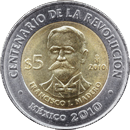
The most important fighter for agrarian rights in the Mexican Revolution. He joined the Maderista movement when it erupted, but he issued the Plan of Ayala and returned to armed struggle when the agrarian demands of the campesinos of Morelos, Puebla, Estado de México, and Mexico City went unmet. The resulting defense of the campesinos' demands led him to confront Madero's regime as well as the dictatorship of Huerta, and to join the Aguascalientes Convention, which resisted Constitutionalism. He was betrayed and assassinated by the forces of Constitutionalist General Pablo González.
The coherence of Zapata's struggle and his agrarian principles, in line with the demands and hopes of the campesino communities of the center and south of Mexico, have given this caudillo a special place in Mexico's history.
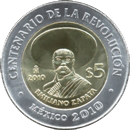
Carranza gave nationalist, legal, and civil meaning to the Mexican Revolution. He headed the fight against Victoriano Huerta by enacting the Plan of Guadalupe, which united the different revolutionary forces, at least for some time. Despite having adopted agrarian principles, he confronted the forces of Zapata and Villa. As the Constitutionalist First Chief, he called the Constitutive Congress of 1916 and enacted the 1917 Constitution. In 1920, faced with disputes that pitted him against revolutionaries from Sonora, he was assassinated in Tlaxcalaltongo by forces loyal to Álvaro Obregón.
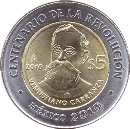
The role of women in the Mexican Revolution was crucial; thousands of anonymous women offered help to large military contingents, feeding them and dressing their wounds, even participating in combat. The feminine presence in the Mexican Revolution should obviously be properly valued and recognized.
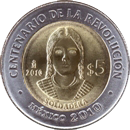
Politician, journalist, and writer. In El Peninsular, he revealed his altruistic and humanitarian ideas. In June 1910, he met Francisco I. Madero and became head of the anti-reelection movement in the southeast. He was nominated candidate for governor of Yucatán, but Díaz issued a warrant for his arrest, so he fled. In April 1910, when the National Independent Convention of the National Anti-reelection and National Democratic parties took place in Mexico City, Pino Suárez was named convention president. The convention nominated Madero as Mexico’s president and Pino Suárez as magistrate of the Supreme Court. Pino Suárez accompanied Madero in his presidential campaign tour and then returned to the southeast to continue fighting for the revolutionary cause.
When the armed revolution broke out, Pino Suárez was in the United States, but at the signing of the treaties of Ciudad Juárez (which sealed the defeat of Porfirio Díaz), Pino Suárez returned to Mexico. In the elections convened by León de la Barra, the team of Madero for president and Pino Suárez for vice president won.
The year 1913 saw the Tragic Ten Days and betrayal by Victoriano Huerta, former ally of the rebels who orchestrated the coup d’état and assassinated Madero and Pino Suárez in March of that year. Pino Suárez and Madero symbolize the fight for democracy in Mexico.
